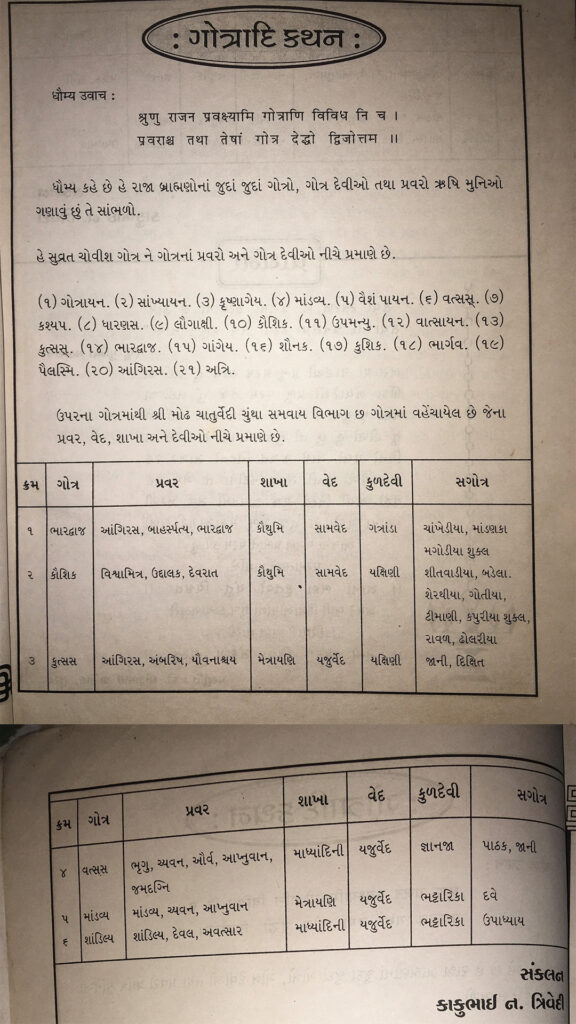About MCCS
If you want to learn more about us, you’re in the right place. Read about our history, geography and roots.
Modheshwari Mata & Modhera temple information
Modheshwari mataji is the main clan deity (Kul-devi) of all the Modh communities of Gujarat.
It is believed that a demon (asur) named Karnat used to harass the Brahmans living at Modhera (then known as Dharmarnaya), so brahmans prayed to local Goddess Shree mata (daughter of Lord Brahma) to protect them from Karnat. Devi Shree mata got very agitated and started breathing fire, from which came out Matangi, a goddess with eighteen arms, each arm carrying a weapon. A fight ensued and Devi Matangi killed Karnat. The brahmans celebrated this victory and accepted Matangi as Modheshwari, their clan-deity (kul-devi). To mark the victory and emergence of Devi Matangi, the Modh community celebrates the Hindu calendar day of Maha Sud Teras every year with big fanfare at Modhera and all Modheshwari temples.
The most prominent temple of Modheshwari mataji is located at Modhera, which is a small town in Mehsana district of Gujarat, India. Another ancient Modheshwari mataji temple is located nearby at Chanasama in Patan taluka of Gujarat. Besides, now there are also many temples of Modheshwari mataji in various places like Ahmedabad, Vadodara, Bhavnagar, Surat, Bharuch, Bhuj, Kapadwanj, Khedbrahma, Ujjain, Sendarda (Junagadh), Tera (Kutch), Jhabua (M.P.) etc. Most of these are of more recent origins.
Modhera town is well known for the Sun Temple of Chaulukya era. The town is located on the bank of river Pushpavati. The town was known as Dharmaranya during Puranic age. It is believed that Lord Rama had performed yagna here to cleanse the sin of killing Brahmin Ravana. He had built Modherak which was later known as Modhera. The famous Sun Temple was built during the reign of Bhima I of Chaulukya dynasty in 1026-1027 (Vikram Samvat 1083). There is also a beautiful stepwell (vaav) Gyaneshwari in village which belongs to 16-17th century.
Background of Modh Brahman community
Modh communities comprise people who originated from Modhera in Gujarat, India. In Gujarat and in Rajasthan, there are many examples of Hindu communities who take their name from a town. Modh’s can be divided broadly in four castes (1) Modh Brahman (2) Modh Vanik (3) Modh Patel (4) Modh Modi. Modh Brahmans are further divided into six sub-castes as:
- Modh Chaturvedi Brahman
- Modh Traividh Brahman
- Modh Dhanuja Brahman
- Modh Tandalja Brahman
- Modh Agiyasana Brahman and
- Modh Jyesthimall Brahman.
Modh Chaturvedi Brahmans can be further grouped in various Samvay such as: Chuntha Samvay, Rajuguru Samvay, Halari Samavay etc. Of these, Modh Chaturvedi Rajguru Samvay Brahman appear to be historically very closely linked with our Chuntha Samvay community, with similar roots and rituals.
Modh Chaturvediya Chuntha Samvay (or MCCS) Brahman community is believed to have recent origins from around Bhavnagar area and prior to that believed to have shifted from present day Rajasthan to Bhavnagar. It can be said that the history of Modh Chaturvediya Chuntha Samvay (or MCCS) Brahman community may be closely linked to the history of Royal family of Bhavnagar which is also believed to have its origins in Rajasthan and then moved towards present day Bhavnagar about 800 years back. Our Modh Chaturvediya Chuntha Samvay (or MCCS) Brahman community is today spread worldwide and the migration is spreading further with every new generation.
Apart from Modh Brahmans, other similar Brahman communities from Saurashtra region are: Audichya Brahman, Gugali Brahman, Unewal Brahman, Khijadiya Brahman etc. Further afar, other similar Brahman communities are Anavil Brahman, Naagar Brahman, Mewada Brahman, Machhu-katiya Brahman, Prashnora Brahman, Girnara Brahman etc.
MCCS Gotra Details
